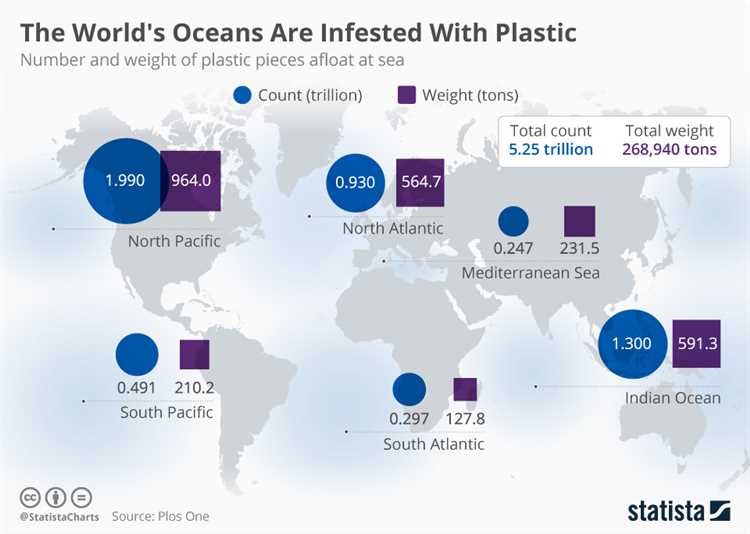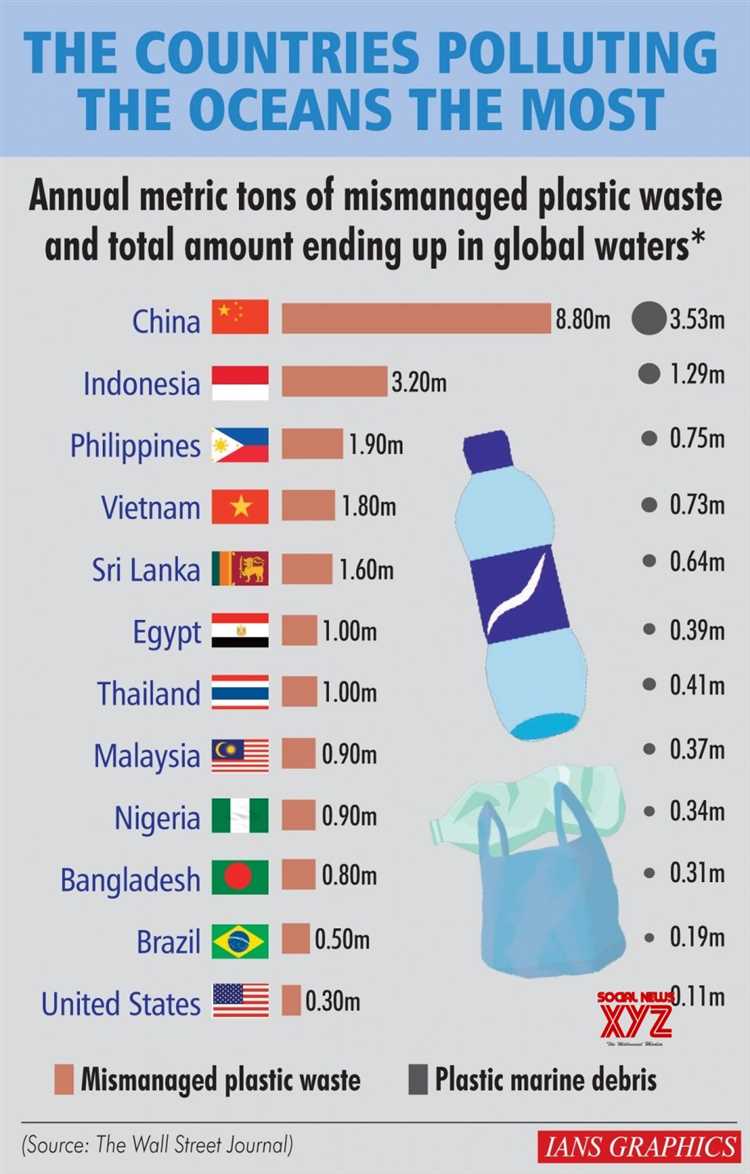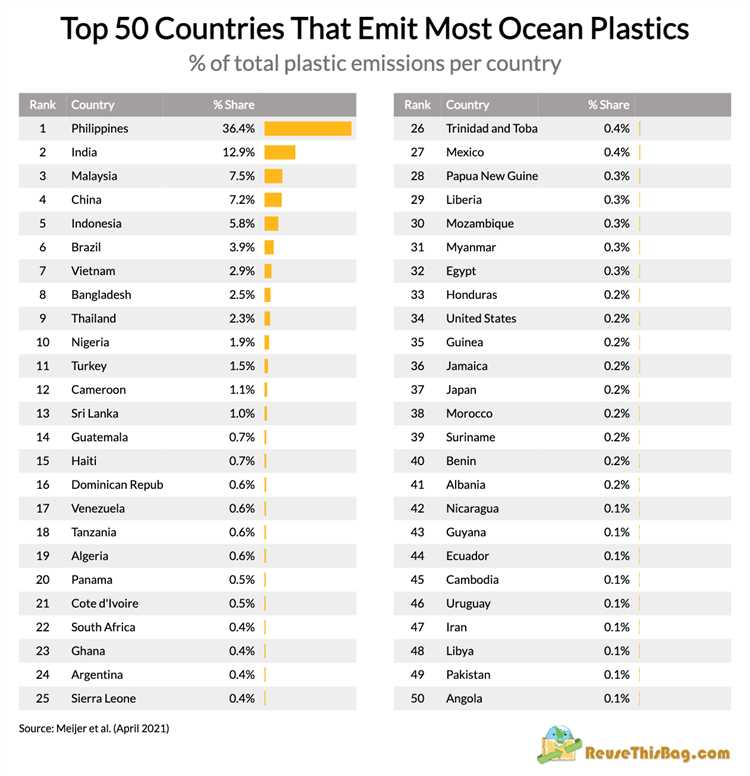
Oceans, covering more than 70% of the Earth’s surface, are facing a dire threat – pollution. The once pristine waters are now being overwhelmed with various types of waste, causing significant harm to marine life and ecosystems. Identifying the main culprits behind ocean pollution is crucial in order to address this global issue effectively. By pinpointing the key contributors, we can focus on implementing strategies and regulations to reduce pollution and protect our oceans for future generations.
When it comes to ocean pollution, one of the biggest culprits is plastic waste. Plastic, known for its durability, is causing immense damage to marine life. Millions of tons of plastic, including bottles, bags, and microplastics, end up in the ocean each year, creating deadly hazards for marine animals. Birds, fishes, and sea turtles are often found entangled in plastic or mistakenly ingest it, leading to severe injuries and even death. To tackle plastic pollution, it is essential to raise awareness about its harmful effects and promote sustainable alternatives to single-use plastic.
Another major contributor to ocean pollution is industrial waste. Factories and manufacturing plants release a significant amount of toxic chemicals and pollutants into nearby water bodies, which eventually find their way into the ocean. These pollutants can cause severe damage to marine ecosystems, impairing the health of coral reefs, harming fish populations, and disrupting the delicate balance of marine life. Stringent regulations and enforcement are crucial to prevent industries from polluting our oceans and to encourage the adoption of cleaner production methods.
Agricultural activities also play a significant role in ocean pollution. The excessive use of fertilizers and pesticides in large-scale farming leads to harmful runoff that enters rivers and eventually flows into the ocean. This runoff causes algal blooms and marine dead zones, where oxygen levels are so low that marine life cannot survive. Implementing better agricultural practices, such as reducing chemical inputs and promoting sustainable farming methods, is essential to reduce the impact of agriculture on ocean pollution.
- Ocean Pollution: A Growing Environmental Crisis
- Causes of Ocean Pollution
- Consequences of Ocean Pollution
- The Great Pacific Garbage Patch: An Oceanic Trash Island
- Causes of the Great Pacific Garbage Patch
- The Environmental Impact
- Industrial Waste: Major Contributors to Ocean Pollution
- Chemical Plants and Refineries
- Oil and Gas Industry
- Plastic Pollution: The Rise of Disposable Culture
- Chemical Pollution: Hidden Dangers Beneath the Surface
- Solutions for a Cleaner Ocean Environment
- Q&A
- What are the main sources of ocean pollution?
- Which industries are the biggest contributors to ocean pollution?
- How does industrial waste pollute the ocean?
- What are the impacts of ocean pollution on marine life?
- What actions can be taken to reduce ocean pollution?
Ocean Pollution: A Growing Environmental Crisis

Ocean pollution is a serious problem that is rapidly becoming one of the biggest environmental crises of our time. Throughout the world, our oceans are being contaminated with various types of waste and pollutants, leading to devastating consequences for marine life and ecosystems.
Causes of Ocean Pollution
There are several significant causes of ocean pollution. One major contributor is plastic waste, particularly single-use plastics like bottles, bags, and straws. These items often end up in the ocean where they can take hundreds of years to break down, posing a significant threat to marine animals who can become entangled in them or mistake them for food.
Another major cause of ocean pollution is chemical and oil spills. Accidental releases of oil and other hazardous substances from ships or offshore drilling operations can have severe and long-lasting impacts on marine habitats. These spills can contaminate water and kill or harm marine life, as well as destroy coastal ecosystems and beaches.
Consequences of Ocean Pollution
The consequences of ocean pollution are far-reaching and devastating. Marine wildlife, such as seabirds, turtles, and dolphins, are often the victims of pollution, suffering from entanglement, ingestion of plastic, and habitat destruction. Additionally, pollution can disrupt the delicate balance of marine ecosystems, leading to a decline in biodiversity and the loss of important species.
Furthermore, ocean pollution can have negative impacts on human health. Consuming contaminated seafood can lead to the ingestion of harmful chemicals and toxins, posing a risk to human well-being. Coastal communities that rely on tourism and fishing also suffer economic losses when pollution taints their beaches and depletes their fish stocks.
It is imperative that immediate action is taken to combat ocean pollution. Governments, organizations, and individuals all have a role to play in reducing waste, promoting recycling, and implementing stricter regulations for industries that contribute to ocean pollution. Only through collective efforts can we hope to mitigate the damage and preserve our oceans for future generations.
The Great Pacific Garbage Patch: An Oceanic Trash Island
The Great Pacific Garbage Patch is a massive area of floating plastic debris located in the Pacific Ocean. With an estimated size twice that of Texas, it has earned the nickname “trash island.” This immense accumulation of marine litter is a result of the currents and wind patterns in the Pacific Ocean that cause the waste to accumulate in a concentrated area.
The garbage patch is primarily made up of plastic, which is one of the most prevalent types of marine debris. Plastic items such as bottles, bags, and microplastics break down into smaller pieces and are carried by ocean currents, eventually forming this enormous patch of trash. The debris poses a significant threat to marine life, as animals mistakenly eat the plastic or get entangled in it, leading to injury, suffocation, and death.
Causes of the Great Pacific Garbage Patch
There are several factors contributing to the formation and growth of the Great Pacific Garbage Patch. One major factor is improper waste disposal, as many people discard plastic items irresponsibly, either on land or at sea. The plastic waste then makes its way into rivers, which eventually flow into the ocean.
Another factor is the poor management of plastic waste by countries along the Pacific Rim. The region’s rapid industrialization and population growth have led to increased plastic consumption and production, exacerbating the issue. Inadequate recycling and waste management systems further contribute to the problem, allowing more plastic to enter the ocean.
The Environmental Impact
The Great Pacific Garbage Patch has severe consequences for the marine ecosystem and the environment as a whole. The plastic pollution disrupts the natural balance of marine life, causing harm to both animals and the entire food chain. Many marine species mistake the plastic for food and ingest it, leading to internal injuries or starvation. The presence of microplastics in the ocean also poses a threat to human health, as they can enter the food chain and be consumed by humans.
Furthermore, the plastic debris in the garbage patch can leach harmful chemicals into the water, polluting the entire ecosystem. These chemicals can contaminate the water supply and have long-term effects on aquatic life and human populations living in coastal areas.
| Effects of the Great Pacific Garbage Patch | Solution |
|---|---|
| Threat to marine life | Reducing plastic consumption and improving waste management |
| Disruption of the food chain | Implementing stricter regulations on plastic production and disposal |
| Water pollution | Education and awareness campaigns on the impact of plastic pollution |
Efforts are being made to clean up the Great Pacific Garbage Patch and prevent further pollution. Innovative technologies, such as ocean cleanup systems and recycling initiatives, are being developed to address the issue. However, it is crucial for individuals, industries, and governments to work together to reduce plastic consumption, improve waste management practices, and ultimately protect our oceans from becoming dumping grounds for plastic waste.
Industrial Waste: Major Contributors to Ocean Pollution
Industrial waste is a significant contributor to ocean pollution, causing severe damage to marine ecosystems around the world. The industrial sector generates a vast amount of waste, including chemicals, heavy metals, and other pollutants that find their way into the oceans through various channels.
One of the main sources of industrial waste is manufacturing processes. Factories and industrial plants release pollutants directly into the air and water, which eventually make their way into the ocean. These pollutants can include toxic chemicals, heavy metals like lead and mercury, and plastic waste.
Chemical Plants and Refineries
Chemical plants and refineries are particularly notorious for their contribution to ocean pollution. These facilities produce a wide range of toxic chemicals and byproducts that are often released into nearby water bodies, eventually reaching the ocean. Contaminants from chemical plants can have serious impacts on marine life, causing issues such as reduced oxygen levels, contamination of food sources, and neurological damage.
Oil and Gas Industry
The oil and gas industry is another major contributor to ocean pollution. Oil spills, both large-scale accidents and smaller leaks, release significant amounts of oil into the ocean, causing ecological disasters. These spills contaminate water, kill marine organisms, and damage coastal habitats. In addition to spills, the extraction and transportation of oil and gas also generate pollution through air emissions and wastewater discharges.
Furthermore, the production and use of plastics by the industrial sector contribute to plastic pollution in the ocean. Plastics not only take hundreds of years to decompose but also break down into microplastics, which are consumed by marine organisms, entering the food chain and having detrimental effects on marine life.
Industrial waste management and regulations play a crucial role in mitigating ocean pollution. Stricter regulations, improved waste treatment technologies, and the adoption of sustainable practices are necessary to minimize the impact of industrial waste on the oceans and protect marine ecosystems for future generations.
Plastic Pollution: The Rise of Disposable Culture

Plastic pollution has become one of the biggest environmental challenges of our time, and it is largely driven by the rise of disposable culture. In recent decades, there has been a significant shift in consumer behavior towards single-use products made of plastic, such as plastic bags, bottles, and packaging.
This disposable culture has been fueled by convenience and affordability. Single-use plastic items are cheap to produce and easy to use, but their long-term impact on the environment is devastating. Plastic waste takes hundreds of years to decompose, and during this process, it releases toxic chemicals into the soil and water, leading to serious damage to ecosystems and marine life.
One major contributor to the rise of disposable culture is the fast-food industry. The convenience of takeaway meals and the use of disposable packaging has led to a massive increase in plastic waste. Plastic containers, cutlery, and straws are used just once and then thrown away, contributing to the growing plastic pollution problem.
Another significant factor is the global beverage industry. The widespread consumption of bottled water, soft drinks, and other beverages packaged in plastic bottles has skyrocketed in recent years. These plastic bottles often end up in landfills or, even worse, in the ocean, where they pose a significant threat to marine ecosystems.
Furthermore, the fashion industry has played a role in the rise of disposable culture. Fast fashion brands produce cheap garments made of synthetic materials, such as polyester, which shed microplastics when washed. These microplastics find their way into rivers and oceans, resulting in plastic pollution that is incredibly difficult to remove.
In order to address the problem of plastic pollution, it is crucial to change our mindset towards disposability. We must move away from single-use plastic products and embrace more sustainable alternatives. This can be achieved through education and awareness campaigns, as well as the development of innovative materials and recycling technologies.
Ultimately, tackling plastic pollution requires a collective effort from individuals, industries, and governments. By reducing our reliance on disposable plastic and implementing more sustainable practices, we can mitigate the detrimental impacts of plastic pollution and preserve our oceans for future generations.
Chemical Pollution: Hidden Dangers Beneath the Surface
Chemical pollution is a significant threat to the world’s oceans, posing hidden dangers beneath the surface. As industries continue to release vast amounts of chemicals into the environment, these substances find their way into the water, wreaking havoc on marine ecosystems.
Chemicals from various sources, including agriculture, industry, and domestic waste, contribute to the pollution of the oceans. Fertilizers, pesticides, and herbicides used in agriculture can be washed into rivers and eventually reach the sea, causing harmful algal blooms and disrupting the natural balance of coastal areas.
Industrial activities also release a wide range of chemicals into the oceans. These include heavy metals from mining operations, oil spills from offshore drilling, and toxic chemicals from manufacturing processes. These pollutants can have devastating effects on marine life, leading to reduced biodiversity, reproductive issues, and even death in some cases.
| Chemical pollutant | Main sources | Environmental impact |
|---|---|---|
| Mercury | Coal-fired power plants, industrial processes | Neurological damage in marine life, bioaccumulation in the food chain |
| Plastics | Single-use plastics, microplastics from textile industry | Entanglement, ingestion, and suffocation of marine animals, habitat destruction |
| Oil | Oil spills from ships and offshore drilling | Coating of marine animals and plants, disruption of ecosystems, loss of habitat |
In addition to direct impacts on marine life, chemical pollution can also have indirect effects on human health. People who consume contaminated seafood may be exposed to harmful chemicals that have bioaccumulated in fish and shellfish. This can lead to a range of health problems, including neurological disorders and cancer.
To address the issue of chemical pollution, strict regulations and enforcement are essential. Industries must be held accountable for their waste management practices, and governments should invest in cleaner technologies and promote sustainable alternatives. Public awareness and education are key to fostering a sense of responsibility towards the oceans and ensuring their long-term health.
In conclusion, chemical pollution poses hidden dangers beneath the surface of our oceans. It is crucial that we take immediate action to reduce and prevent further contamination. By addressing the sources of chemical pollution and implementing effective measures, we can protect marine ecosystems and preserve the health of our oceans for future generations.
Solutions for a Cleaner Ocean Environment
1. Reduce Plastic Pollution: One of the major contributors to ocean pollution is plastic waste. To combat this issue, it is essential to reduce the use of single-use plastics such as bags, straws, and bottles. Encouraging individuals and businesses to use reusable alternatives can greatly reduce plastic waste in the oceans.
2. Improve Waste Management: Proper waste management practices are crucial to preventing waste from entering our oceans. Implementing effective recycling programs and promoting responsible disposal of waste can help minimize marine pollution. Additionally, stricter regulations and penalties for illegal dumping can deter polluters.
3. Promote Sustainable Fishing Practices: Overfishing and destructive fishing practices can harm marine ecosystems and deplete fish populations. Encouraging sustainable fishing methods such as using selective fishing gear, respecting fishing quotas, and establishing marine protected areas can help protect marine life and maintain a healthy ocean environment.
4. Support Renewable Energy Sources: Fossil fuel combustion releases toxic chemicals and contributes to the acidification of the oceans. Embracing renewable energy sources such as wind and solar power can reduce pollution, mitigate climate change impacts, and ultimately improve the health of our oceans.
5. Raise Awareness and Education: Increasing public awareness about ocean pollution and its consequences is vital in promoting behavioral changes. Educational campaigns about the importance of sustainable practices, responsible consumer choices, and the impact of pollution on marine ecosystems can empower individuals to make a positive difference.
6. Strengthen International Cooperation: Ocean pollution is a global issue that requires international cooperation to address effectively. Collaborating with other countries, sharing best practices, and developing international agreements can lead to more coordinated efforts in combating ocean pollution.
By implementing these solutions, we can work towards a cleaner and healthier ocean environment for future generations.
Q&A
What are the main sources of ocean pollution?
The main sources of ocean pollution are industrial waste, marine debris, sewage, oil spills, and agricultural runoff.
Which industries are the biggest contributors to ocean pollution?
The industries that contribute the most to ocean pollution are the manufacturing industry, the agricultural industry, and the oil and gas industry.
How does industrial waste pollute the ocean?
Industrial waste pollutes the ocean through the discharge of toxic chemicals, heavy metals, and other hazardous materials into waterways, which eventually make their way to the ocean.
What are the impacts of ocean pollution on marine life?
Ocean pollution has numerous impacts on marine life, including entanglement and ingestion of marine debris, habitat destruction, harmful algal blooms, and the disruption of marine ecosystems.
What actions can be taken to reduce ocean pollution?
Actions that can be taken to reduce ocean pollution include implementing stricter regulations on industrial waste disposal, promoting recycling and waste reduction, improving sewage treatment systems, and raising awareness about the issue.